Wednesday Walk: Farm Embers
A fire at a local farm, $1 is better than free, New Jersey billboards
Welcome to Willoughby Hills!
If you enjoy what you’re reading, please consider a free subscribtion to receive emails every Wednesday and Sunday plus podcast episodes every two weeks. There are also paid options, which unlock even more features.
Every Wednesday, I offer a few short ideas that I hope will inspire you to do some more reading, thinking, and exploring. Let’s take a little walk together and see where the path leads…
A Local Farm Tragedy
I’ve written about Red Fire Farm in Western MA a few times in this newsletter. In 2022, they were running a fundraiser after market conditions that year put them in danger of losing their farm.
I’ve been a big fan of Red Fire Farm for many years, buying a lot of their produce during winter farmers markets and at farm stands in Eastern Massachusetts. One of the motivators for us buying our new house in Western Mass was that it was about 10 minutes from Red Fire’s farm store. We still plan to join their CSA after we finish our move.
On Saturday afternoon, a fire broke out at the farm store barn and greenhouse in Granby, MA and completely destroyed both structures. The damage is estimated at $1 million.
A local news report describes the significance of the former barn:
“Built in the late 1920s after a lightning strike burned the former barn down, it was constructed with beams made of local American chestnut, a once-common tree species prized for its timber that has since been largely wiped out in America by a fungus.”
I’ve only visited this farm in person a few times, but every time, I was completely enamored. At the height of summer, fresh produce lined nearly every surface. The fridges were stocked with fresh greens, local eggs, local dairy, and local meats. There were small batch vinegars and sustainable locally roasted coffee on the shelf.
For much of the day, the farm stand was self serve with no cashier. Some farms I know that use this system have some kind of self checkout system where barcodes can be scanned or items weighed. At Red Fire, there was a calculator and a credit card machine. Customers were expected to remember the prices of the items that they were purchasing and either leave cash in a locked box or use the credit card reader and deposit the receipt behind. A beautiful hand lettered sign explained the procedure. I loved it all!
I had taken these photos on various visits to the farm, thinking I might someday publish a photo essay about quirky self serve farm stands. Sadly, that idea is now past tense when it comes to Red Fire’s barn, although the farm still survives and most of their winter storage crops were stored at a different location. They plan to continue to sell at farmers markets throughout the winter and spring and hope to have some kind of temporary structure in place for the start of spring CSA season.
If you’re interested in lending any support to the rebuilding effort, the farm has established a GoFundMe. Any amount you can contribute will go a long ways towards rebuilding this amazing place.
Red Fire Farm is just one of the places drawing us to Western Massachusetts, but long before we decided to move, their effects could be felt throughout the state and region.
Valuing Stuff
As we’ve been trying to pack and clean our house to prepare for our move, we’ve been going back and forth on the best way to handle things that we either no longer need or that our kids have outgrown.
We’ve considered donating all of it to thrift stores, although there’s no guarantee whether it will be sold in the store, thrown in a dumpster, or shipped around the world. We also considered a garage sale/yard sale/rummage sale (depending on where you live and your particular vernacular), but it felt like a lot of effort for a small return.
I’ve tried selling a handful of select items on eBay, but they seem to just keep going unsold and being relisted week after week. It’s also a lot of effort to accurately describe each item and meticulously photograph it.
My wife has been a part of Buy Nothing groups, where people list what they have for free and give it to others in the community, but that was also fraught with logistical challenges.
About a week ago, she decided to list a playhouse that our kids had outgrown on Facebook Marketplace and was surprised with the response. There were numerous people interested and it was picked up within hours.
She and our kids have now been experimenting with selling lots of other items on Marketplace, most for around $1 each. Over just the last few days, she’s sold more than a dozen items.
This whole process has been less about making money and more about finding people that are willing to reuse our items. Ironically though, setting a price, even if it’s as trivial as $1, seems to place a greater value on the items for people.
For $1, people show up on time and pick up the item promptly. There are often several people competing for the same item. When it’s listed for free, people say they will come by, only to waffle and make excuses. Perhaps this says something larger about human nature and how we place value on things.
Either way, we feel better knowing that our stuff is going to a home that actually may enjoy it locally rather than ending up in a landfill or on a ship headed somewhere else.
On the NJ Turnpike
We were drove our RV down to Pennsylvania this weekend to pickup some furniture (we needed a large vehicle and the RV is basically a truck). On the drive home, I noticed two billboards of note on the New Jersey Turnpike.
The first one of note was a billboard paid for by the Muslim Public Affairs Council with the simple message “Let Gaza Live, Ceasefire Now.” It caught our attention, and I hope will encourage people who have not been following the genocide of the Palestinians to research the issue closer.
The other one of note was for the Buc-ee’s gas station chain, which started in Texas and has since spread to other parts of the U.S., mostly in the South (I’ve written about Buc-ee’s before). These billboards have become a staple of Southern road trips, but I was surprised to see one this far north.
There isn’t a Buc-ee’s in New Jersey though. There isn’t one even close to New Jersey. The closest location was not only 581 miles away (in Florence, SC), but it was 581 miles in the other direction (I was headed north on the Turnpike, hence the “U-turn” on the billboard).
Which leads me to wonder why Buc-ee’s would pay for a billboard nearly 600 miles from their closest filling station. Might one be announced in the Garden State sometime soon? Is this a way to build northern allegiance to a brand before Spring Break? Is the hope that people will talk about this strange billboard on social media and in random newsletters like this one?
A quick Google search reveals that local news outlets are writing about this billboard too, so if the goal was to build buzz, mission accomplished I guess?
I just wish Americans (and hey, I’m including myself in here too) would spend more time contemplating the Gaza billboard and what it means than whether or not the “world’s largest gas station” is or is not coming to I-95 sometime soon.
I publish new issues every Wednesday and Sunday. Sign up to always receive the latest issue and support my work:
Other Wednesday Walks
If you’ve missed past issues of this newsletter, they are available to read here.





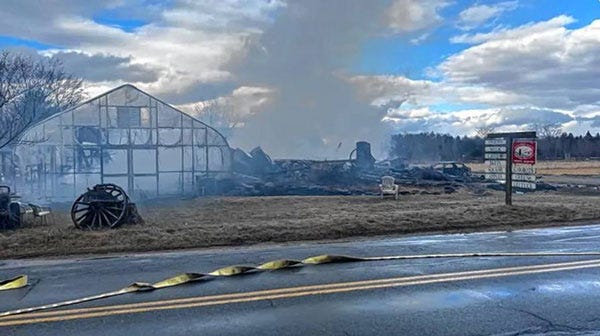

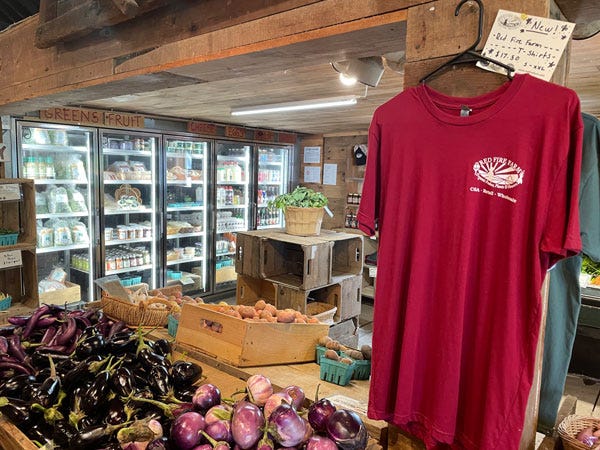
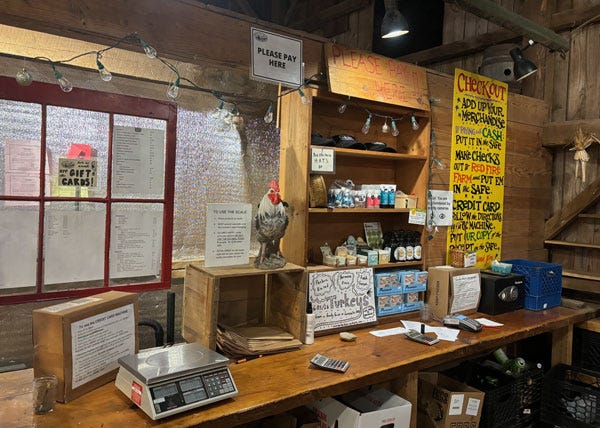

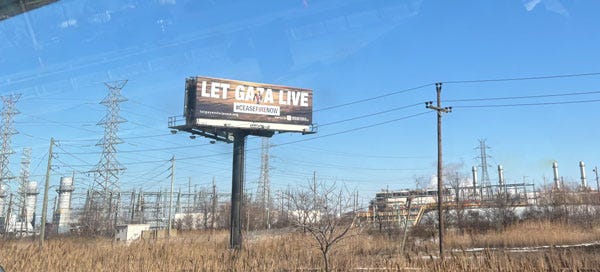
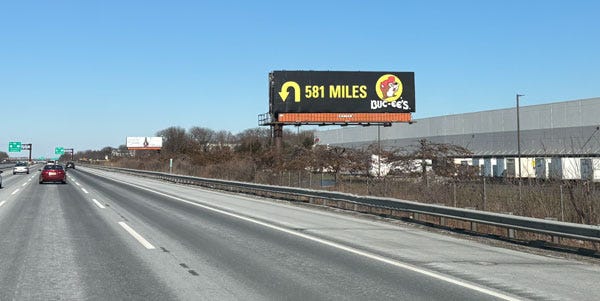
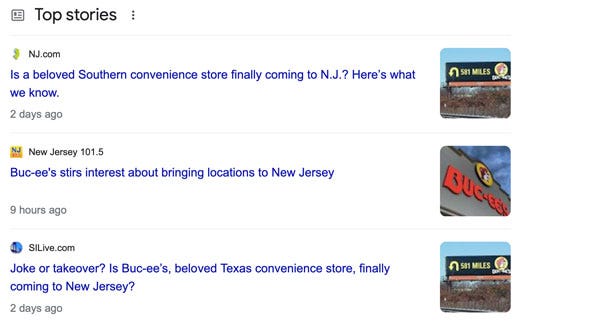
I am behind on reading you interesting story. Where are y’all moving to? So sad about the farm store.
Linda. PS: Buc-ees recently open in our area, Springfield MO.